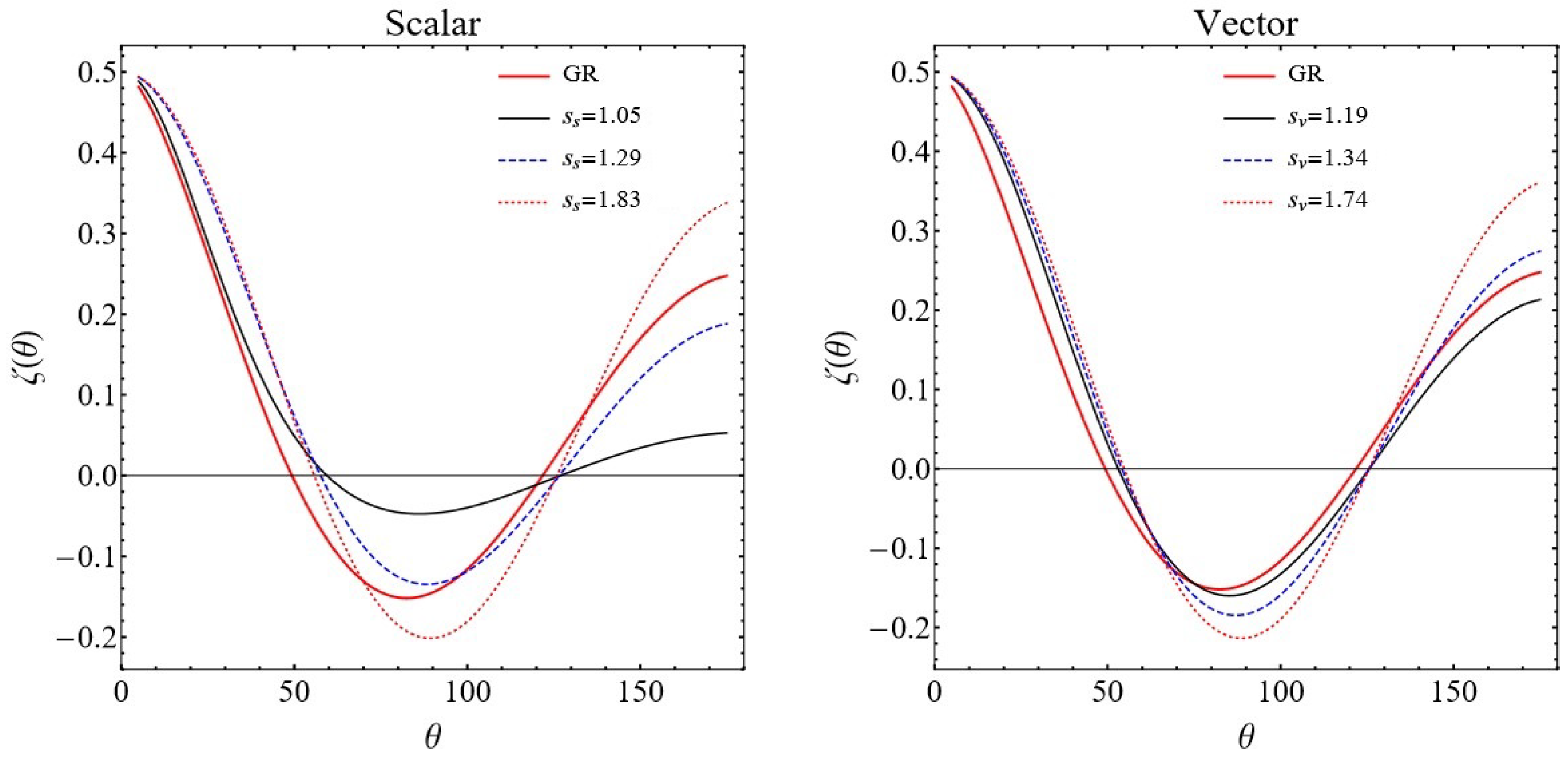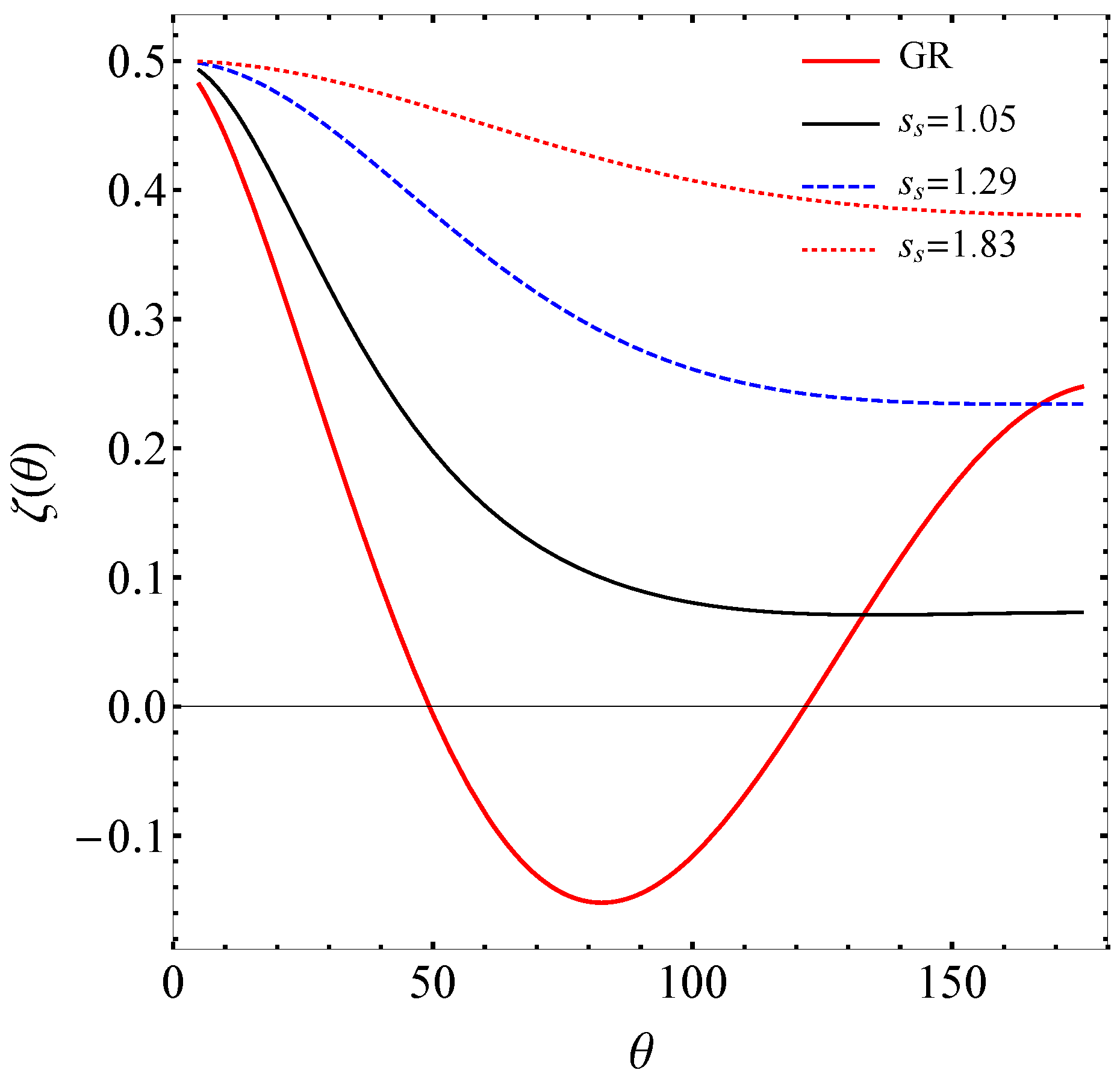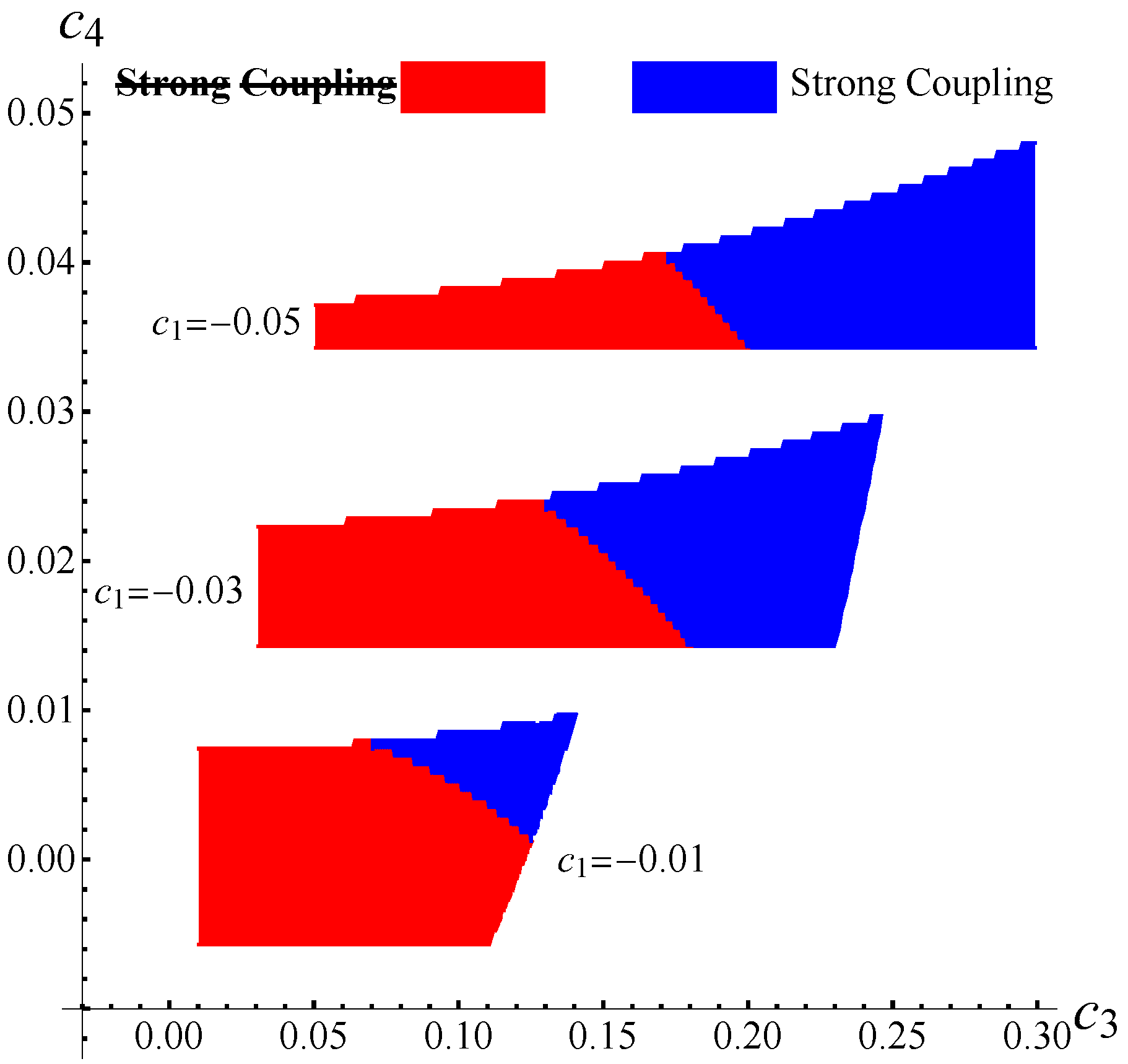Gravitational Waves in Einstein-Æther Theory and Generalized TeVeS Theory after GW170817
Abstract
1. Introduction
2. Gravitational Waves in Einstein-Æther Theory
3. Gravitational Waves in the Generalized TeVeS Theory
4. Conclusions
Author Contributions
Funding
Acknowledgments
Conflicts of Interest
References
- Abbott, B.P.; et al. Observation of Gravitational Waves from a Binary Black Hole Merger. Phys. Rev. Lett. 2016, 116, 061102. [Google Scholar] [CrossRef] [PubMed]
- Abbott, B.P.; et al. GW151226: Observation of Gravitational Waves from a 22-Solar-Mass Binary Black Hole Coalescence. Phys. Rev. Lett. 2016, 116, 241103. [Google Scholar] [CrossRef] [PubMed]
- Abbott, B.P.; et al. GW170104: Observation of a 50-Solar-Mass Binary Black Hole Coalescence at Redshift 0.2. Phys. Rev. Lett. 2017, 118, 221101. [Google Scholar] [CrossRef] [PubMed]
- Abbott, B.P.; et al. GW170814: A Three-Detector Observation of Gravitational Waves from a Binary Black Hole Coalescence. Phys. Rev. Lett. 2017, 119, 141101. [Google Scholar] [CrossRef] [PubMed]
- Abbott, B.P.; et al. GW170817: Observation of Gravitational Waves from a Binary Neutron Star Inspiral. Phys. Rev. Lett. 2017, 119, 161101. [Google Scholar] [CrossRef] [PubMed]
- Abbott, B.P.; et al. GW170608: Observation of a 19-solar-mass Binary Black Hole Coalescence. Astrophys. J. 2017, 851, L35. [Google Scholar] [CrossRef]
- Goldstein, A.; Veres, P.; Burns, E.; Briggs, M.S.; Hamburg, R.; Kocevski, D.; Wilson-Hodge, C.A.; Preece, R.D.; Poolakkil, S.; Roberts, O.J.; et al. An Ordinary Short Gamma-Ray Burst with Extraordinary Implications: Fermi-GBM Detection of GRB 170817A. Astrophys. J. 2017, 848, L14. [Google Scholar] [CrossRef]
- Savchenko, V.; Ferrigno, C.; Kuulkers, E.; Bazzano, A.; Bozzo, E.; Brandt, S.; Chenevez, J.; Courvoisier, T.L.; Diehl, R.; Domingo, A.; et al. INTEGRAL Detection of the First Prompt Gamma-Ray Signal Coincident with the Gravitational-wave Event GW170817. Astrophys. J. 2017, 848, L15. [Google Scholar] [CrossRef]
- Eardley, D.M.; Lee, D.L.; Lightman, A.P. Gravitational-wave observations as a tool for testing relativistic gravity. Phys. Rev. D 1973, 8, 3308–3321. [Google Scholar] [CrossRef]
- Capozziello, S.; De Laurentis, M.; Luongo, O.; Ruggeri, A. Cosmographic Constraints and Cosmic Fluids. Galaxies 2013, 1, 216–260. [Google Scholar] [CrossRef]
- Capozziello, S.; De Laurentis, M.; Luongo, O. Connecting early and late universe by f(R) gravity. Int. J. Mod. Phys. D 2014, 24, 1541002. [Google Scholar] [CrossRef]
- Will, C.M. The Confrontation between General Relativity and Experiment. Living Rev. Rel. 2014, 17, 4. [Google Scholar] [CrossRef] [PubMed]
- Liang, D.; Gong, Y.; Hou, S.; Liu, Y. Polarizations of gravitational waves in f(R) gravity. Phys. Rev. D 2017, 95, 104034. [Google Scholar] [CrossRef]
- Hou, S.; Gong, Y.; Liu, Y. Polarizations of Gravitational Waves in Horndeski Theory. Eur. Phys. J. C 2018, 78, 378. [Google Scholar] [CrossRef]
- Gong, Y.; Hou, S. Gravitational Wave Polarizations in f(R) Gravity and Scalar-Tensor Theory. In Proceedings of the 13th International Conference on Gravitation, Astrophysics and Cosmology and 15th Italian-Korean Symposium on Relativistic Astrophysics (IK15), Seoul, Korea, 3–7 July 2017; Volume 168, p. 01003. [Google Scholar]
- Jacobson, T.; Mattingly, D. Gravity with a dynamical preferred frame. Phys. Rev. D 2001, 64, 024028. [Google Scholar] [CrossRef]
- Seifert, M.D. Stability of spherically symmetric solutions in modified theories of gravity. Phys. Rev. D 2007, 76, 064002. [Google Scholar] [CrossRef]
- Konoplya, R.A.; Zhidenko, A. Gravitational spectrum of black holes in the Einstein-Aether theory. Phys. Lett. B 2007, 648, 236–239. [Google Scholar] [CrossRef]
- Konoplya, R.A.; Zhidenko, A. Perturbations and quasi-normal modes of black holes in Einstein-Aether theory. Phys. Lett. B 2007, 644, 186–191. [Google Scholar] [CrossRef]
- Jacobson, T.; Mattingly, D. Einstein-Aether waves. Phys. Rev. D 2004, 70, 024003. [Google Scholar] [CrossRef]
- Flanagan, E.E.; Hughes, S.A. The Basics of gravitational wave theory. New J. Phys. 2005, 7, 204. [Google Scholar] [CrossRef]
- Gong, Y.; Hou, S.; Liang, D.; Papantonopoulos, E. Gravitational waves in Einstein-æther and generalized TeVeS theory after GW170817. Phys. Rev. D 2018, 97, 084040. [Google Scholar] [CrossRef]
- Jacobson, T. Einstein-aether gravity: A Status report. In Proceedings of the From Quantum to Emergent Gravity: Theory and Phenomenology, Trieste, Italy, 11–15 June 2007. [Google Scholar]
- Elliott, J.W.; Moore, G.D.; Stoica, H. Constraining the new Aether: Gravitational Cerenkov radiation. J. High Energy Phys. 2005, 2005, 066. [Google Scholar] [CrossRef]
- Bekenstein, J.D. Relativistic gravitation theory for the MOND paradigm. Phys. Rev. D 2004, 70, 083509. [Google Scholar] [CrossRef]
- Sagi, E. Preferred frame parameters in the tensor-vector-scalar theory of gravity and its generalization. Phys. Rev. D 2009, 80, 044032. [Google Scholar] [CrossRef]
- Sagi, E.; Bekenstein, J.D. Black holes in the TeVeS theory of gravity and their thermodynamics. Phys. Rev. D 2008, 77, 024010. [Google Scholar] [CrossRef]
- Lasky, P.D.; Sotani, H.; Giannios, D. Structure of Neutron Stars in Tensor-Vector-Scalar Theory. Phys. Rev. D 2008, 78, 104019. [Google Scholar] [CrossRef]
- Lasky, P.D. Black holes and neutron stars in the generalized tensor-vector-scalar theory. Phys. Rev. D 2009, 80, 081501. [Google Scholar] [CrossRef]



| 7.7 | 8.4 | 9.1 | 6.06 | 3.59 | 2.83 | ||
| −5.5 | −6.2 | −6.8 | 3.66 | 2.58 | 2.10 | ||
| 6.3 | 5.6 | 4.9 | |||||
| −5.2 | −3.7 | −2.6 | |||||
| 1.74 | 1.34 | 1.19 | 1.74 | 1.34 | 1.19 | ||
| 1.83 | 1.29 | 1.05 | 1.83 | 1.29 | 1.05 |
© 2018 by the authors. Licensee MDPI, Basel, Switzerland. This article is an open access article distributed under the terms and conditions of the Creative Commons Attribution (CC BY) license (http://creativecommons.org/licenses/by/4.0/).
Share and Cite
Hou, S.; Gong, Y. Gravitational Waves in Einstein-Æther Theory and Generalized TeVeS Theory after GW170817. Universe 2018, 4, 84. https://doi.org/10.3390/universe4080084
Hou S, Gong Y. Gravitational Waves in Einstein-Æther Theory and Generalized TeVeS Theory after GW170817. Universe. 2018; 4(8):84. https://doi.org/10.3390/universe4080084
Chicago/Turabian StyleHou, Shaoqi, and Yungui Gong. 2018. "Gravitational Waves in Einstein-Æther Theory and Generalized TeVeS Theory after GW170817" Universe 4, no. 8: 84. https://doi.org/10.3390/universe4080084
APA StyleHou, S., & Gong, Y. (2018). Gravitational Waves in Einstein-Æther Theory and Generalized TeVeS Theory after GW170817. Universe, 4(8), 84. https://doi.org/10.3390/universe4080084






